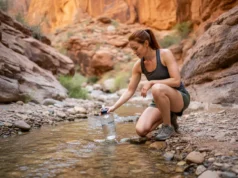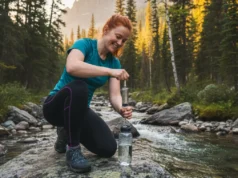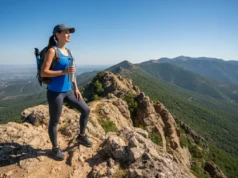In this article
The stream tumbles over granite, crystal clear and ice-cold—the very picture of pristine. But the most significant dangers in the backcountry are the ones you can’t see. This guide moves beyond a simple “filter vs. purifier” debate. It equips you with a wilderness instinct, teaching you how to read the landscape, understand microscopic threats, and build a water-treatment strategy that keeps you safe on trail anywhere in the world. You’ll begin worried about microscopic dangers and confused by pore-size efficacy; you’ll finish feeling empowered with a trail-smart water decision card—a printable PDF ready for your pocket.
What Invisible Threats Lurk in Backcountry Water?
What are the three classes of waterborne pathogens?
The microscopic world of backcountry water revolves around three classes of pathogens, each defined by size and behavior. Protozoa—the “large” parasites like Giardia lamblia and Cryptosporidium cysts—measure 2–15 microns, large enough to be blocked by a standard 0.2-micron hollow-fiber membrane, and originate almost exclusively from animal-waste contamination, making them a universal concern across the U.S. & Canada backcountry. Bacteria, the “medium” threats such as E. coli, Salmonella, and Campylobacter, fall into the 0.2–8 micron window and share the same fecal transmission route, so both bacteria and protozoa are caught by any reputable microfilter. Viruses—Norovirus, Hepatitis A, Rotavirus, and Cholera—are the “smallest” offenders at 0.02–0.1 microns, slip through 0.2-micron pores, and require either 0.02 µm absolute ultra-filtration, electro-adsorption, UV-C sterilization, or chlorine dioxide for reliable neutralization. Together, these organisms form a size spectrum, and any filter’s effectiveness is a direct function of its filtration pore size versus pathogen size.
Yet size is only part of the story. Cryptosporidium cysts possess stubborn chlorine-resistant shells, meaning iodine tabs may fail, while chlorine dioxide (Aquamira drops) or certified purifier technologies succeed. The most dangerous human viruses are transmitted almost exclusively through human fecal matter, so pathogen prevalence rises sharply wherever population density and sanitation infrastructure are poor. Turbidity—silty or tannic water—physically shields all pathogen types from UV-C and prematurely clogs mechanical filters. Memorizing Latin names is unnecessary; what matters is building a threat model that asks whether you’re defending against large protozoa, medium bacteria, or tiny viruses, because that single question dictates whether you reach for a water filter or a water purifier. According to official EPA data provides the authoritative bedrock for this entire discussion, and understanding these threats is part of your Ten Essentials system.
Why does my hiking location determine if I need a filter or a purifier?
The choice between filter and purifier hinges on one fundamental difference: a water purifier removes or inactivates viruses; a standard water filter does not. In the remote U.S. & Canada backcountry, the primary contamination source is animal waste, so the dominant threats are bacteria and protozoa; a high-quality 0.1–0.2-micron hollow-fiber filter (e.g., Sawyer MINI, Katadyn BeFree) is therefore sufficient for most scenarios. Venture into developing countries or remote villages, however, and water sources are often contaminated with human waste, dramatically increasing the risk of contracting Norovirus, Hepatitis A, or Cholera; in that context a purifier becomes non-negotiable. Your trip region is the single best predictor of whether the smallest and most elusive threat—viruses—will be present.
The line is not strictly international. High-traffic domestic areas—popular trailheads, crowded basecamps, or glacial meltwater zones downstream from livestock—can also harbor viral contamination from human sources, making a purifier a smart choice even inside the US. Agricultural runoff introduces yet another variable: the potential for chemical or pesticide contamination, which most filters and purifiers do not address without an activated carbon stage. The decision, then, is not a universal rule but a trip-type risk assessment; rather than asking “which is better?” you ask “which gear combination matches the level of risk I am willing to accept on this specific trip?” CDC guidance on water disinfection for travelers is the definitive government source for domestic vs. international protocols, and this principle becomes crystal clear when planning a trek in Patagonia or anywhere else abroad.
How Do Water Treatment Technologies Actually Work?
What’s the difference between a hollow-fiber filter and a purifier?
Mechanical filtration is the workhorse of backcountry hydration safety, operating like a microscopic sieve. At its core is the hollow-fiber membrane, a bundle of tiny tubes whose 0.1–0.2-micron pores physically block bacteria and protozoa while allowing water molecules to pass. Water purifiers go beyond that barrier to defeat viruses through additional technologies: ultra-filtration filters with 0.02 µm absolute pores—such as the MSR Guardian—physically block viruses outright; electro-adsorption devices like the Grayl GeoPress and RapidPure Intrepid rely on positively charged UltraCeram® media that act like a magnet-like electro-adsorption trap for negatively charged pathogens, including viruses, at faster flow rates than ultra-filtration; and UV-C light pens like the SteriPEN Ultra scramble microbial DNA so the organisms cannot reproduce. Each method has distinct strengths, but all share the goal of neutralizing the smallest threats.
Chemical disinfection with chlorine dioxide drops (e.g., Aquamira drops) kills all three pathogen classes, yet requires up to a 30-min wait to defeat Cryptosporidium while iodine tabs are faster yet ineffective against Crypto and leave an iodine taste; they also carry health warnings. Activated carbon is often misunderstood; it does not remove pathogens but instead adsorbs chemicals, pesticides, and foul tastes or odors, serving as a useful taste improvement stage in systems like the Grayl GeoPress. A strategic fork in the road lies between building a modular system—say, a lightweight Sawyer MINI for bacteria and protozoa plus Aquamira drops for viruses—and opting for an all-in-one device such as the GeoPress. The modular approach is typically lighter, cheaper, and offers redundancy, but demands more user knowledge, whereas the integrated device is nearly foolproof yet heavier, bulkier, and costlier over time. Wilderness Medical Society guidelines for water disinfection corroborate these technical explanations, and a deeper dive into how activated charcoal works clarifies its role as a secondary stage.
Why does the NSF P231 certification matter so much?
Official terminology draws a bright line: a “water filter” must remove bacteria and protozoa, whereas a “water purifier” must meet the EPA Guide Standard by also removing viruses. The marketplace, however, is rife with vague claims of “NSF standards,” and many consumers unwittingly rely on NSF 42/53 certifications that were designed for residential tap water and test for chlorine taste or lead rather than backcountry water pathogens. The gold standard for wilderness use is NSF P231, a protocol that specifically challenges microbiological purifiers with two types of water: one clear and one simulated “worst-case” wilderness water that is cold, turbid, and laden with organic matter and all three pathogen types.
A device that merely “meets EPA standards” has cleared the minimum bar, but one that has been independently certified to the NSF P231 protocol has proven its mettle under the harshest conditions a hiker is likely to encounter. Seeing the specific NSF P231 certification on packaging or the manufacturer’s website provides a very high degree of confidence that marketing claims are backed by rigorous, third-party testing. When the stakes are your health on trail, NSF P231 is the benchmark that separates marketing hype from proven, reliable performance. For broader context on choosing the best hiking and camping gear, this certification is a non-negotiable filter in your decision matrix.
How Do I Choose the Right System for My Hike?
What four questions will guide me to the perfect water system?
Begin with four sequential questions that slice through the noise of specs and marketing—our cheat-sheet basic distinctions distilled into a dynamic risk-assessment flowchart:
- WHERE are you hiking?
• U.S. & Canada backcountry ? filter usually suffices.
• Developing countries, remote villages, or glacial meltwater zones downstream from livestock ? purifier mandatory. - WHAT is your primary water source?
• Clear streams and lakes allow most systems.
• Silty, murky, or tannic water demands a pump or ceramic cartridge that’s easy to back-flush and may render UV-C ineffective. - HOW do you hike?
• Solo/ultralight backpackers prize weight & packability (grams/ounces) and flow rate (L/min) from squeeze vs. gravity vs. pump options.
• Group/basecamp hikers need high capacity and speed. - WHAT is your budget priority?
• Lowest initial & recurring cost = Sawyer MINI (100,000 gal life).
• Convenience over cost = Grayl GeoPress (8 s press, replaceable cartridge).
Put the scenario-driven comparison guide into practice:
- An AT thru-hiker follows 1A → 2A → 3A → 4A and lands on the Sawyer MINI—ultralight, field maintainable, pennies per liter.
- A South America trekker maps 1B → 2A/B → 3A → 4B and chooses the Grayl GeoPress because virus protection is non-negotiable.
- A family base-camp traces 1A → 2A → 3B → 4B and opts for the Platypus GravityWorks 4 L—effortless gravity filtration for a crowd.
Answer these four questions in order and our interactive quiz outputs a personalized gear list; print the Trail-Smart Water Decision Card (PDF) and slip it into your pack—skills essential for anyone graduating from day hiker to backpacker.
Pro-Tip: Tape the four-question flowchart inside your pack lid; when you’re tired and dehydrated, simple checklists save lives.
Water Filter & Purifier Comparison
Expand each product to see detailed specifications and an affiliate link to purchase.
Key Specs
Weight: 2 oz / 57 g
Flow Rate: ~1.0 L/min (squeeze)
Removes Viruses: No
Key Specs
Weight: 3 oz / 85 g
Flow Rate: ~1.7 L/min (squeeze)
Removes Viruses: No
Key Specs
Weight: 2.3 oz / 65 g
Flow Rate: ~2.0 L/min (squeeze)
Removes Viruses: No
Key Specs
Weight: 3.15 oz / 89 g
Flow Rate: ~0.5 L/min (squeeze)
Removes Viruses: No
Technology & Cost
Technology: Hollow-Fiber, Carbon
Life: 2,000 L (fiber), 100 L (carbon)
Initial Cost: ~$40
Key Specs
Weight: 11.5 oz / 326 g
Flow Rate: ~1.75 L/min (gravity)
Removes Viruses: No
Key Specs
Weight: 17.3 oz / 490 g
Flow Rate: ~2.5 L/min (pump)
Removes Viruses: Yes
Technology & Cost
Technology: Ultra-filtration (0.02µm)
Life: 10,000+ L
Initial Cost: ~$400
Key Specs
Weight: 15.9 oz / 450 g
Flow Rate: ~5.0 L/min (press)
Removes Viruses: Yes
Key Specs
Weight: 9.2 oz / 261 g
Flow Rate: ~1.2 L/min (suck)
Removes Viruses: Yes
Technology & Cost
Technology: Electro-adsorption + Carbon
Life: 75 L (purifier), 757 L (filter)
Initial Cost: ~$50
Key Specs
Weight: 4.9 oz / 140 g
Flow Rate: 1.0 L / 90 sec
Removes Viruses: Yes
Key Specs
Weight: 2 oz / 57 g (for 30 gal)
Flow Rate: N/A (4 hr wait)
Removes Viruses: Yes
How Do I Keep My Gear (and Myself) Safe on Trail?
Why is freezing a hollow-fiber filter so dangerous?
When temperatures drop, water trapped inside the delicate hollow-fiber membrane expands as it freezes, and ice crystals behave like microscopic knives, shearing micro-fractures into the filter element. These new, enlarged pores are invisible yet large enough for bacteria and protozoa to slip through unimpeded. The danger is compounded because the filter still passes water, giving false confidence while delivering unsafe water. If you suspect your hollow-fiber filter has frozen, assume it is compromised and discard it—there is no field integrity test for most models, as reinforced by guidance from the National Park Service.
Pro-Tip: In winter, dedicate one dry stuff-sack as your “filter sleeping bag.” Slide the filter inside, add a hand-warmer packet, and keep it at the foot of your quilt—simple insurance against a silent failure.
Prevention is straightforward but non-negotiable. In cold-weather performance situations, carry the filter in an inside jacket pocket where body heat keeps it above 32 °F, or sleep with it inside your sleeping bag. Some technologies shrug off freezing: the MSR Guardian pump purifier is engineered for freeze tolerance, and electro-adsorption purifiers like RapidPure Intrepid also survive freeze-thaw cycles, though viral efficacy may drop after multiple events.
Conclusion
Location dictates risk: a 0.1–0.2-micron filter is usually adequate in remote U.S. & Canada backcountry, while developing countries, remote villages, or crowded domestic zones mandate a purifier to guard against viruses. Every treatment method—hollow-fiber membranes, UV-C pens, electro-adsorption cartridges, chlorine dioxide drops—offers a unique balance of weight & packability, flow rate, cartridge life, and cost-benefit. There is no single “best” system, only the “best fit” for your specific needs. A frozen hollow-fiber filter is a compromised filter, and vigilance against cold-weather performance is essential. Ultimately, skills outrank gear; the most advanced purifier is useless without knowledge to avoid cross-contamination, perform field maintenance, and recognize limitations. Master the fundamentals here, then explore our full library of backcountry gear guides to build a complete, trail-ready system with confidence.
Backpacking Water Purification & Filtration
Do I really need a water purifier for hiking in the US?
For most remote backcountry hiking in the U.S. & Canada, a high-quality water filter that removes bacteria and protozoa is considered sufficient protection because animal waste—not human waste—dominates the pathogen prevalence. However, a purifier is recommended if you are hiking in high-use areas with heavy human traffic or near agricultural zones where viral or chemical contamination is a higher risk.
What is the difference between a 0.1 and 0.2 micron filter?
Both 0.1 and 0.2-micron hollow-fiber filters are effective at removing bacteria and protozoa and therefore meet the standard for a microbiological water filter. The 0.1-micron rating offers slightly higher pore-size efficacy, but for practical backcountry purposes in removing the target pathogens, both ratings are considered safe and effective.
Can viruses pass through a Sawyer MINI?
Yes, viruses such as Norovirus or Hepatitis A are too small to be physically blocked by the 0.1-micron absolute pores of standard hollow-fiber filters like the Sawyer MINI. These devices are water filters, not purifiers, and do not provide protection against viruses.
How often should I replace my backpacking filter cartridge?
Replacement depends on the type of filter. Press-style purifiers like the Grayl GeoPress have a defined cartridge life—typically around 250 litres before replacement—signaled by increased press time, whereas hollow-fiber filters like the Sawyer MINI can last for 100,000 gal life if properly back-flushed and maintained. Replace a hollow-fiber cartridge when flow rate drops dramatically and field maintenance no longer restores performance.
Risk Disclaimer: Hiking, trekking, backpacking, and all related outdoor activities involve inherent risks which may result in serious injury, illness, or death. The information provided on The Hiking Tribe is for educational and informational purposes only. While we strive for accuracy, information on trails, gear, techniques, and safety is not a substitute for your own best judgment and thorough preparation. Trail conditions, weather, and other environmental factors change rapidly and may differ from what is described on this site. Always check with official sources like park services for the most current alerts and conditions. Never undertake a hike beyond your abilities and always be prepared for the unexpected. By using this website, you agree that you are solely responsible for your own safety. Any reliance you place on our content is strictly at your own risk, and you assume all liability for your actions and decisions in the outdoors. The Hiking Tribe and its authors will not be held liable for any injury, damage, or loss sustained in connection with the use of the information herein.
Affiliate Disclosure: We are a participant in the Amazon Services LLC Associates Program, an affiliate advertising program designed to provide a means for us to earn advertising fees by advertising and linking to Amazon.com. As an Amazon Associate, we earn from qualifying purchases. We also participate in other affiliate programs and may receive a commission on products purchased through our links, at no extra cost to you. Additional terms are found in the terms of service.





